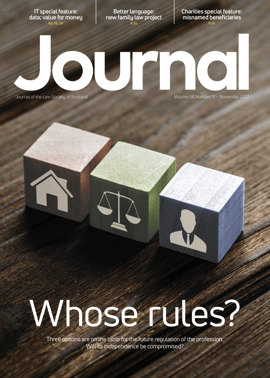Who gets to make the rules?

You may feel that we have been here before.
A consultation has opened on the future of legal services regulation in Scotland. This latest Scottish Government exercise, however, is closer to being the precursor to new legislation that could have a far-reaching impact on the profession. It is one that practising lawyers should be taking an interest in, and letting their views be known.
Sharply opposing views have been aired since Esther Roberton’s review in 2018 recommended a single new regulator covering all branches of the legal profession, independent of the profession and taking in the functions of the Scottish Legal Complaints Commission. She believes that her approach would put Scotland at the forefront of modern professional services regulation; but it is strongly opposed by the Law Society of Scotland and Faculty of Advocates, who see a threat to professional independence since appointments to the regulator would be made by, or by those capable of being influenced by, the Government. How, then, is the Government proceeding?
Three contrasting alternative models are proposed, one reflecting the Roberton proposal; one involving a market regulator similar to the present position in England & Wales; and one that can be seen as the present system with added transparency, all as outlined below.
Before detailing these, the consultation sets out the regulatory principles and objectives that it intends should apply – essentially those identified by Roberton, along with the human rights PANEL principles of participation, accountability, non-discrimination, empowerment and legality. The objectives should be uncontroversial, but consultees are asked to rate the importance they attach to each. They include protecting and promoting the public interest; supporting the rule of law; independence and adherence to professional principles; access to justice (including choice, affordability and understanding); a culture of prevention, quality assurance and compliance; collaboration between provider and consumer interests; the better regulation principles; and promoting competition.
Model 1: Roberton
Esther Roberton’s model is the first option. A new, single independent regulator would be responsible for entry, standards, monitoring, complaints and redress in respect of all branches of the legal profession. The Society, Faculty and equivalent regulators would become professional membership organisations, working with the regulator and representing their members’ interests, providing CPD (as approved), professional services and guidance, and pursuing their interests in law reform. But the regulator would be the rollkeeper for all legal professionals and be responsible for all aspects of regulation including issuing practising certificates, setting practice rules and professional standards, financial inspections, complaints handling, the client protection fund, and establishing a reconstituted disciplinary tribunal.
The regulator’s chair would be appointed through, and only be removable by, the Scottish Parliament; its board would have equal numbers of legal and non-legal members (the former perhaps appointed by the Lord President; the latter perhaps by ministers), and would require to embed a consumer voice.
Funded by a levy on regulated individuals and entities, the paper dares to suggest that the cost would be no more than the current framework, a simpler complaints process helping to achieve savings.
Model 2: Market regulator
The second option parallels the current position in England & Wales. The professional bodies would retain their regulator roles – to be carried out by an independent statutory regulatory committee within each authorised regulator – but be authorised and overseen by an independent market regulator, to which the regulatory committees would report. The paper points to the Society’s Regulatory Committee as the model, but Council members would not be allowed to sit on it. The SLCC would also continue to operate.
Appointed in a similar way to the option 1 regulator, except that ministers would appoint the chair through a public appointments process, the market regulator would have three main roles:
- to authorise the regulators, with the ability to act or make recommendations to counter gaps, geographic or sector related, in service provision;
- to monitor, counter and mitigate risks within the sector, through “a broad regulatory toolkit”;
- to act as an impartial economic regulator, aiming to align and balance professional and consumer/client interests.
While it would set minimum entry standards, quality assure CPD, and carry out research into the legal services market, individual regulators would set their own entry standards, develop codes of conduct and standards in line with set criteria, regulate entities or practitioners as appropriate, and retain PII and client protection responsibilities.
The regulator would be accountable to the Scottish Parliament.
When it was mooted at the time of the 2010 legal services legislation, the Scottish Government decided that a body of this nature was excessive in a jurisdiction the size of Scotland. Funded by a levy on those regulated, the present paper again predicts no increase in costs, though the only indications as to how this would be achieved are that “a very small staffing complement” would be required, additional bodies could in future be regulated and therefore billed, and the complaints system would be less complex.
Issues around professional independence can also be expected to be raised with this model.
Model 3: Enhanced accountability and transparency
This model is the closest to the present regime, but with enhanced accountability and transparency through the other professional bodies having to constitute regulatory committees similar to the Society’s, each one embedding a consumer voice (through a mechanism to be decided).
Further changes would be a focus on entity and corporate regulation, and an ability to seek to regulate in other jurisdictions. A joint working group would assess and make recommendations to the Scottish Government and the Financial Conduct Authority as to future regulation of claims management companies in Scotland; it would also review reserved activities and the definition of legal services, and make recommendations based on changes in the market.
Were this model to be adopted, the Society would find itself ahead of the game, having its Regulatory Committee already in place, and with no new external oversight to come to terms with.
The broader picture
Complaints is one area on which there is more consensus on the direction of reform. Here the paper sets out a lengthy list of regulatory principles, derived from Roberton. Catching the eye are a reference to mediation as “a key process which should be built upon”; the levy for entities being on a financial turnover basis; and a simplified and restricted appeals process, with no appeal in respect of service issues or compensation awards.
We could also see a single Discipline Tribunal emerge, incorporated into the Scottish Tribunals (which would assist in the collection of financial penalties). And the Scottish Parliament might at last be given a say in approving the complaints handling budget.
The paper acknowledges that depending on the favoured option, the role of the Lord President in approving professional rules may change. It asks for views on the importance of his role, whether in future it should be a “consultative” or a “consent” role, and whether he should have a role in the appointment of legal members to regulatory committees (under models 2 and 3) and in arbitrating any disputes between the committees and their relative professional bodies.
Regardless of the model pursued, the Government wants the regulatory framework to incorporate a greater emphasis on quality assurance, prevention of failures that usually lead to consumer complaints, and continuous improvement for the benefit of the profession and consumers.
It also sees the reforms as an opportunity for Scottish regulators to simplify their rules, with the aim of reducing their length and making them more proportionate and consumer friendly. This is not fleshed out.
The paper asks whether “legal services” should be defined in legislation, without itself attempting a definition; whether the activities reserved to solicitors should be expanded, reduced, or left untouched; and whether the descriptions “lawyer” and “advocate” (and any others) should be protected in the same way as “solicitor”.
With the 2010 provisions enabling licensed legal services providers never having been brought into force, it raises the question whether the required majority ownership by regulated professionals remains appropriate given the UK and international market in which Scottish firms now operate, as well as the increased interest in employee or community ownership. Alongside this, entity regulation is proposed, including a fitness test for entities.
A few other miscellaneous matters: the paper covers fitness to practise – whether the current criteria are adequate, whether they should be applied at more career points than the present admission and re-admission stages, and whether there should be a test for non-lawyer owners or managers. It follows up the Roberton report warning against creating legislative barriers to new services provided through legal tech – should legal tech be considered “legal services”, and therefore regulated, and if so, how? Finally, is the client protection fund working, and should it be transferred to any new regulator?
Opposing views
The Competition & Markets Authority, which takes an interest in the provision of legal services, favours Roberton’s independent regulator model. To quote its research report of March 2020, this is seen as “the best way to ensure that regulation can protect consumer interests”, including by promoting competition, improved choice and innovation, the better regulation principles, and independence in regulatory decision-making. In a brief final chapter acknowledging the CMA’s report, the Government comments that it will respond to the CMA when it responds to the consultation, since views are being sought on many of its recommendations.
The central issue remains: should the present regulators – the Society, the Faculty, and the Association of Commercial Attorneys – retain their functions as such, or hand them over in whole or part to a new body, independent of the professions but appointed by bodies connected with the state? The latter outcome is backed by Roberton, the CMA, and also the SLCC, which has called for “fundamental reform” to create a system that is “independent, accountable and transparent”. Also in this issue, Lorna Jack, for the Society, sets out its objections in principle to that approach, as does the President in his column.
Those who wish to read the paper for themselves, and to express their own view, can do so here.
They have until 24 December to respond.
Regulars
Perspectives
Features
Briefings
In practice
Online exclusive
In this issue
- Good legal software suppliers listen to you
- The trends that will shape law firms in 2022
- Technology won't solve everything...
- Key trends in legal tech adoption for UK law firms
- The top 4 benefits of moving to a cloud solution
- Why cyber risk management is not the same as IT support
- Business growth: finding the right package






